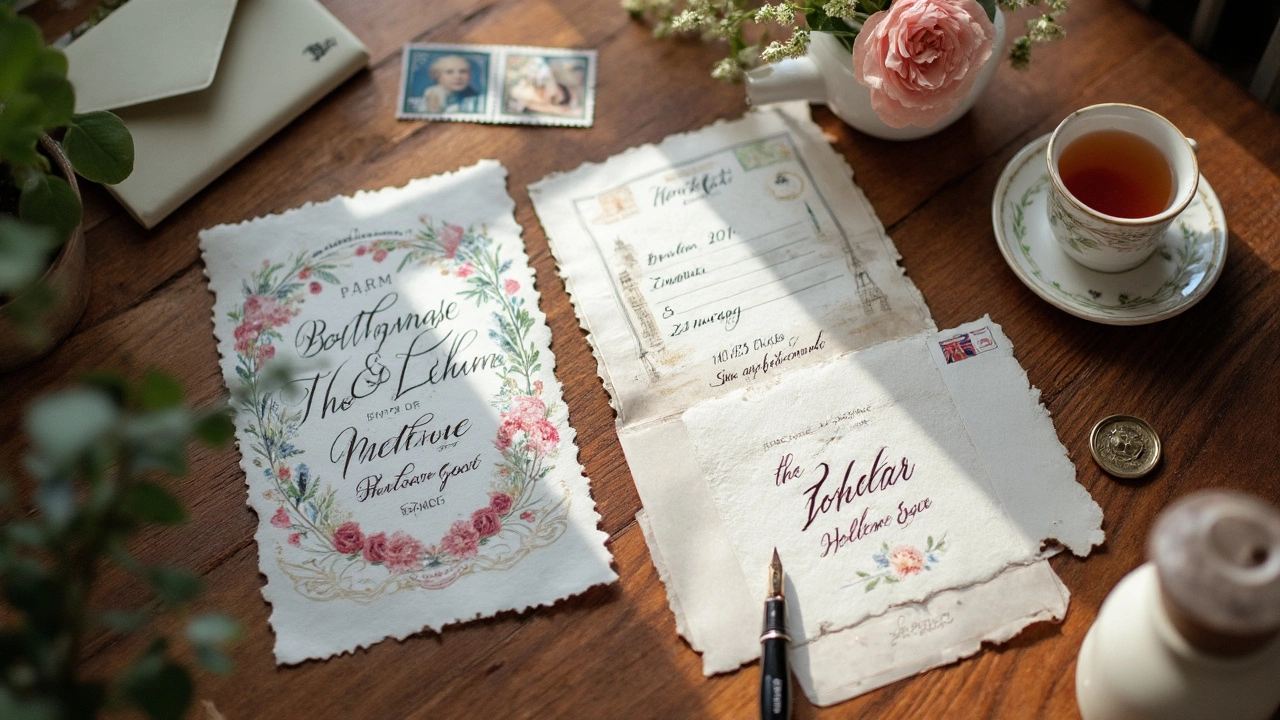Screwing up a wedding invitation is easier than you think—forget one key detail, and suddenly Grandma shows up at the wrong church. So, what should you actually put on your invitation? You need more than just the date and an address. Names (first and last), location, time, dress code (if any), and clear RSVP info are all must-haves. If you’re having a wedding website with directions or a gift registry, it's smart to include that link on a separate enclosure card instead of crowding your main invite.
People always wonder about wording. Do you have to make it sound stiff and formal, or can you be more relaxed? It really depends on your vibe, but the invitation should match the style of your wedding. Traditional invites use formal language like “request the pleasure of your company,” while backyard BBQ weddings can sound more like, “Join us for some good eats and celebration!” The key is being straightforward so no one’s left guessing about anything.
- What to Include on a Wedding Invitation
- When and How to Send Your Invites
- Handling Plus-Ones and Special Situations
- RSVPs: Making It Easy for Everyone
What to Include on a Wedding Invitation
Getting the details right on your wedding invitations saves a lot of confusion for everyone. It’s more than just names and a date. The info you include is basically your game plan for the day—and for most guests, it's the only info they’ll have until the big event.
- Full names of the couple: Don’t leave anyone guessing. Include first and last names, especially if your families don’t know each other well. No nicknames unless your wedding is super laid-back and everyone’s in the know.
- Date and time: Be clear, down to the minute. Writing “Saturday, June 14th, 2025, at 4:00 PM” beats just “June 14.” Guests like to plan ahead.
- Venue name and address: Make the location crystal clear. Adding a city and even a zip code is smart—especially if your venue shares a name with others nearby.
- Who’s hosting: This is usually at the top. If parents, both sets, you as a couple, or everyone together is hosting, spell it out. It’s a tradition thing, but it also clears up who’s organizing what.
- Dress code (if any): You’d be surprised how much grief this one detail saves. Even just “casual” or “cocktail attire” gives people a heads up.
- RSVP instructions: Don’t let this get buried. Include a by-when date if you’re going the old-school mail route, or a link/phone number if you’re digital. And be direct—“Please RSVP by May 1st.”
- Extra details (optional cards): If you have a wedding website, hotel info, directions, or a shuttle schedule, put these on a separate card. Shoving everything onto one invite stresses people (and looks messy).
Couples sometimes worry about putting too much out there, but clarity wins every time. When in doubt, add a detail card or direct guests to your website. Clear info means fewer last-minute calls asking if the ceremony is at noon or three.
When and How to Send Your Invites
Timing is everything with wedding invitations. Send them too early, and guests might forget. Send them too late, and you’ll have a bunch of awkward phone calls or last-minute RSVP panic. The golden rule? For most weddings, mail your invitations about 8 to 10 weeks before the big day. If you’re planning a destination wedding or you know most guests will travel, bump it up to 3 months, so people have room to budget and make plans.
'Save-the-dates' are a newer trend in the US, starting to take off around the 2000s. These are especially helpful if you're getting married during busy seasons, or if guests need to book flights or time off work. Standard advice says send save-the-dates 6 to 8 months out, sometimes even a year if you're tying the knot somewhere far-flung.
| Mail-Out | Recommended Timing |
|---|---|
| Save-the-date | 6-12 months before |
| Formal invitation | 8-10 weeks before |
| RSVP deadline | 3-4 weeks before wedding |
The best way to send your wedding invitations? For traditional weddings, sticking with printed, mailed invites shows you mean business. Use good old USPS, and yes, hand-addressing envelopes is still considered best practice. People notice when you care about these little touches. If you’re doing something more casual (or have a tech-savvy crew), digital invitations are totally fine and surprisingly easy to track. Websites like Paperless Post or even wedding-specific features in Google Calendar have made this a legit option.
Here’s a simple checklist before sending:
- Double check all names and addresses—typos are brutal here.
- Make sure you have proper postage (overweight or oddly shaped invites need extra stamps).
- If your event is around holidays or long weekends, add extra mailing time.
- Make it easy for guests to RSVP—include a pre-stamped envelope or a clear online link.
One last tip: always order 10-20% extra invitations. Someone always gets forgotten, or you’ll need a last-minute invite for your cousin’s new girlfriend.

Handling Plus-Ones and Special Situations
Dealing with plus-ones gets sticky fast. So many couples wonder, “Who actually gets a plus-one?” The short answer: It’s up to you. There’s no solid rule, but some practical guidelines help keep things fair (and avoid drama).
- If someone’s married, engaged, or in a serious long-term relationship (think living together or years together), a plus-one is basically expected.
- Single friends or coworkers? You’re not obligated to offer a plus-one unless your guest list and budget allow. If you want everyone to bring someone, cool—just keep it consistent.
- Kids are a special case. If it’s a kid-friendly wedding, make that clear on the invite or have separate wording for families. If not, use phrases like “adults only reception” to avoid awkward surprises.
The biggest mistake is assuming guests know who’s invited. Always write out exactly who is welcome on the envelope and on the invitation. For example, "Ms. Taylor Jones and Guest" signals a plus-one, while "Mr. Chris Miller" means solo guest.
Did you know that a recent survey by The Knot found that 79% of couples set clear rules for plus-ones on their wedding invitations? Turns out, fewer guests get confused when the invite spells it out. Here’s a simple overview of what’s typical:
| Type of Guest | Plus-One? |
|---|---|
| Married, engaged, cohabitating | Yes |
| In a new relationship/ casual date | Optional |
| Single friend | Optional |
| Family with kids | Only if kids are invited |
When in doubt, it’s better to over-communicate. Special diet needs, accessibility, or out-of-towners? Add a quick note in your invite packet or on your website to show you’ve got their needs covered. A little clarity in your wedding invitations goes a long way toward avoiding last-minute messages (or awkward moods) on your big day.
RSVPs: Making It Easy for Everyone
Collecting RSVPs should not feel like herding cats, but it so often does. Making it simple for your guests means fewer headaches for you. The way you handle this part can seriously shape your stress levels as the big day gets closer. So let’s talk about how to set it up right from the start.
First off, give your guests multiple ways to reply. Some folks love filling out a paper card, while others are glued to their phones. It's totally normal now to include an RSVP card with a pre-stamped envelope and also offer a digital option—think wedding website or even a simple text if you're keeping things casual.
- Set a clear RSVP deadline—3-4 weeks before the wedding is the sweet spot. Caterers and venues need your headcount early, sometimes four weeks in advance.
- Make it clear if guests get a plus-one or if kids are invited. The RSVP card is the spot to spell it out. Blank lines or specific names will avoid confusion.
- If you use a wedding website, mention it right on the invite or an insert card. Include the exact URL—not just a QR code, in case someone's phone doesn't cooperate.
It helps to personalize where possible. If you're sending traditional mail, pre-fill your guest's name on the RSVP card so Cousin Dave doesn't try to bring his whole soccer team. If you're using digital RSVPs, double-check that each guest has their own link or spot to reply—especially for bigger guest lists.
Here's a quick look at how people are sending and receiving RSVPs lately:
| RSVP Method | How Common (2024 Survey) |
|---|---|
| Paper Mail Back | 42% |
| Online via Wedding Website | 53% |
| Email/Text | 5% |
A handy tip: Keep track of your responses in a spreadsheet or use wedding planning apps—they often have RSVP trackers built in. That way, you know at a glance who’s in and who still needs a reminder.
And when the RSVP deadline comes and goes? Don’t be shy—follow up! Most people aren’t ignoring you on purpose; sometimes cards get tossed, emails get lost, or Aunt Linda needs a gentle nudge. A quick message can save major hassle with your wedding invitations and seating chart later on.
